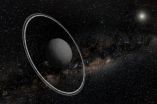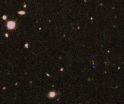(Press-News.org) Boston, MA — A large international consortium of researchers has produced the first comprehensive, detailed map of the way genes work across the major cells and tissues of the human body. The findings describe the complex networks that govern gene activity, and the new information could play a crucial role in identifying the genes involved with disease.
"Now, for the first time, we are able to pinpoint the regions of the genome that can be active in a disease and in normal activity, whether it's in a brain cell, the skin, in blood stem cells or in hair follicles," said Winston Hide, associate professor of bioinformatics and computational biology at Harvard School of Public Health (HSPH) and one of the core authors of the main paper in Nature. "This is a major advance that will greatly increase our ability to understand the causes of disease across the body."
The research is outlined in a series of papers published March 27, 2014, two in the journal Nature and 16 in other scholarly journals. The work is the result of years of concerted effort among 250 experts from more than 20 countries as part of FANTOM 5 (Functional Annotation of the Mammalian Genome). The FANTOM project, led by the Japanese institution RIKEN, is aimed at building a complete library of human genes.
Researchers studied human and mouse cells using a new technology called Cap Analysis of Gene Expression (CAGE), developed at RIKEN, to discover how 95% of all human genes are switched on and off. These "switches"—called "promoters" and "enhancers"—are the regions of DNA that manage gene activity. The researchers mapped the activity of 180,000 promoters and 44,000 enhancers across a wide range of human cell types and tissues and, in most cases, found they were linked with specific cell types.
"We now have the ability to narrow down the genes involved in particular diseases based on the tissue cell or organ in which they work," said Hide. "This new atlas points us to the exact locations to look for the key genetic variants that might map to a disease."
INFORMATION:
Funding for FANTOM 5 came from a research grant from RIKEN and from Innovative Cell Biology.
"A promoter-level mammalian expression analysis," Alistair R. R. Forrest; Hideya Kawaji; J. Kenneth Baillie; Michiel J. L. de Hoon; Timo Lassmann; Masayoshi Itoh; Kim M. Summers, Harukazu Suzuki, Carsten O. Daub, Jun Kawai, Peter Heutink, Winston Hide, Tom C. Freeman, Boris Lenhard, Vladimir B. Bajic, Martin S. Taylor, Vsevolod J. Makeev, Albin Sandelin, David A. Hume, Piero Carninci and Yoshihide Hayashizaki, Nature, March 27, 2014
About Harvard School of Public Health
Harvard School of Public Health brings together dedicated experts from many disciplines to educate new generations of global health leaders and produce powerful ideas that improve the lives and health of people everywhere. As a community of leading scientists, educators, and students, we work together to take innovative ideas from the laboratory and the classroom to people's lives—not only making scientific breakthroughs, but also working to change individual behaviors, public policies, and health care practices. Each year, more than 400 faculty members at HSPH teach 1,000-plus full-time students from around the world and train thousands more through online and executive education courses. Founded in 1913 as the Harvard-MIT School of Health Officers, the School is recognized as America's oldest professional training program in public health.
HSPH on Twitter: http://twitter.com/HarvardHSPH
HSPH on Facebook: http://www.facebook.com/harvardpublichealth
HSPH on You Tube: http://www.youtube.com/user/HarvardPublicHealth
HSPH home page: http://www.hsph.harvard.edu
First comprehensive atlas of human gene activity released
New findings will help identify genetic causes of disease
2014-03-26
ELSE PRESS RELEASES FROM THIS DATE:
Brain degeneration in Huntington's disease caused by amino acid deficiency
2014-03-26
Working with genetically engineered mice, Johns Hopkins neuroscientists report they have identified what they believe is the cause of the vast disintegration of a part of the brain called the corpus striatum in rodents and people with Huntington's disease: loss of the ability to make the amino acid cysteine. They also found that disease progression slowed in mice that were fed a diet rich in cysteine, which is found in foods such as wheat germ and whey protein.
Their results suggest further investigation into cysteine supplementation as a candidate therapeutic in people ...
Cosmic collision creates mini-planet with rings
2014-03-26
Until now, rings of material in a disc have only been observed around giant planets like Jupiter, Uranus, Neptune and especially Saturn, which is known for its spectacular rings. Now astronomers from the Niels Bohr Institute, among others, have observed the first miniature planet with two rings of ice and pebbles. It is a smaller celestial body, called Chariklo, located two billion kilometers out in the solar system between Saturn and Uranus. The results are published in the prestigious scientific journal, Nature.
Chariklo was located in the Kuiper Belt, a collection ...
New maps for navigating the genome unveiled by scientists
2014-03-26
Scientists have built the clearest picture yet of how our genetic material is regulated in order to make the human body work.
They have mapped how a network of switches, built into our DNA, controls where and when our genes are turned on and off.
University of Edinburgh scientists played a leading role in the international project – called FANTOM5 – which has been examining how our genome holds the code for creating the fantastic diversity of cell types that make up a human.
The three year project, steered by the RIKEN Center for Life Science Technologies in Japan, ...
Keeping secrets in a world of spies and mistrust
2014-03-26
VIDEO:
This is an interview with Professor Artur Ekert, co-inventor of quantum cryptography, about what it takes to keep secrets secret.
Click here for more information.
Revelations of the extent of government surveillance have thrown a spotlight on the security – or lack thereof – of our digital communications. Even today's encrypted data is vulnerable to technological progress. What privacy is ultimately possible? In the 27 March issue of Nature, the weekly international ...
Cell-saving drugs could reduce brain damage after stroke
2014-03-26
Long-term brain damage caused by stroke could be reduced by saving cells called pericytes that control blood flow in capillaries, reports a new study led by scientists from UCL (University College London).
Until now, many scientists believed that blood flow within the brain was solely controlled by changes in the diameter of arterioles, blood vessels that branch out from arteries into smaller capillaries. The latest research reveals that the brain's blood supply is in fact chiefly controlled by the narrowing or widening of capillaries as pericytes tighten or loosen around ...
Should whole-genome sequencing become part of newborn screening?
2014-03-26
That question is likely to stir debate in coming years in many of the more-than-60 countries that provide newborn screening, as whole-genome sequencing (WGS) becomes increasingly affordable and reliable. Newborn screening programs – which involve drawing a few drops of blood from a newborn's heel – have been in place since the late 1960s, and are credited with having saved thousands of lives by identifying certain genetic, endocrine or metabolic disorders that can be treated effectively when caught early enough. Advocates of routine WGS for newborns argue that the new technology ...
Solar System's edge redefined
2014-03-26
Washington, D.C.—The Solar System has a new most-distant member, bringing its outer frontier into focus.
New work from Carnegie's Scott Sheppard and Chadwick Trujillo of the Gemini Observatory reports the discovery of a distant dwarf planet, called 2012 VP113, which was found beyond the known edge of the Solar System. This is likely one of thousands of distant objects that are thought to form the so-called inner Oort cloud. What's more, their work indicates the potential presence of an enormous planet, perhaps up to 10 times the size of Earth, not yet seen, but possibly ...
Penn Dental Medicine-NIH team reverses bone loss in immune disorder
2014-03-26
Patients with leukocyte adhesion deficiency, or LAD, suffer from frequent bacterial infections, including the severe gum disease known as periodontitis. These patients often lose their teeth early in life.
New research by University of Pennsylvania School of Dental Medicine researchers, teaming with investigators from the National Institutes of Health, has demonstrated a method of reversing this bone loss and inflammation.
The work was led by Penn Dental Medicine's George Hajishengallis, professor in the Department of Microbiology, in collaboration with Niki Moutsopoulos ...
Researchers present comprehensive 'roadmap' of blood cells
2014-03-26
(WASHINGTON, March 26, 2014) – Research published online today in Blood, the Journal of the American Society of Hematology, presents an unprecedented look at five unique blood cells in the human body, pinpointing the location of key genetic regulators in these cells and providing a new tool that may help scientists to identify how blood cells form and shed light on the etiology of blood diseases.
Work published today in Blood* is a subset of a much larger catalog of genetic information about nearly 1,000 human cells and tissues unveiled today from the international research ...
3-D MRI scans may offer better way to predict survival after chemo for liver tumors
2014-03-26
In a series of studies involving 140 American men and women with liver tumors, researchers at Johns Hopkins have used specialized 3-D MRI scans to precisely measure living and dying tumor tissue to quickly show whether highly toxic chemotherapy – delivered directly through a tumor's blood supply – is working.
The investigators say their findings, to be presented March 22-27 in San Diego at the annual meeting of the Society of Interventional Radiology, are the first "proof of principle" that this technology can show tumors in three dimensions and accurately measure tumor ...
LAST 30 PRESS RELEASES:
Chronic kidney disease poisons patients’ hearts, scientists discover
Hollings researchers reveal why some pancreatic tumors behave differently
DNA ties gut motility to vitamin B1
Study suggests pathway for life-sustaining conditions in Europa’s ocean
Researchers discover potential new target to treat Parkinson’s disease
Global societies unite to address environmental threats to heart health
Artificial light at night extends pollen season
Women see AI as riskier than men do
Push and pull in models of human migration
Mapping comedic timing, ta-da!
SEOULTECH researchers reveal strong public support for hydrogen fuel cell trucks
Dongguk University develops a new way to produce cheaper, more efficient green hydrogen
Scientists discover a hidden RNA “aging clock” in human sperm
New quantum boundary discovered: Spin size determines how the Kondo effect behaves
Ancient ‘spaghetti’ in dogs’ hearts reveals surprising origins of heartworm
Full value added tax on meat: a first step towards pricing the environmental damages caused by diets
Hidden mpox exposure detected in healthy Nigerian adults, revealing under-recognized transmission
Shingles vaccine linked to slower biological aging in older adults
A self-assembling shortcut to better organic solar cells
A two-week leap in breeding: Antarctic penguins’ striking climate adaptation
Climate risks to insurance and reinsurance of global supply chains
58% of patients affected by 2022 mpox outbreak report lasting physical symptoms
Golden Gate method enables rapid, fully-synthetic engineering of therapeutically relevant bacteriophages
Polar weather on Jupiter and Saturn hints at the planets’ interior details
Socio-environmental movements: key global guardians of biodiversity amid rising violence
Global warming and CO2 emissions 56 million years ago resulted in massive forest fires and soil erosion
Hidden order in quantum chaos: the pseudogap
Exploring why adapting to the environment is more difficult as people age
Society for Laboratory Automation and Screening welcomes new scientific director: Madeline M. Farley, Ph.D.
Austrian cow shows first case of flexible, multi-purpose tool use in cattle
[Press-News.org] First comprehensive atlas of human gene activity releasedNew findings will help identify genetic causes of disease


